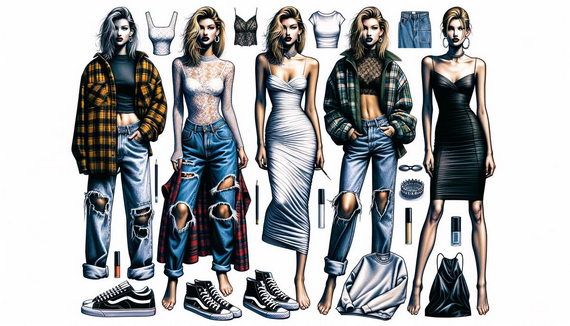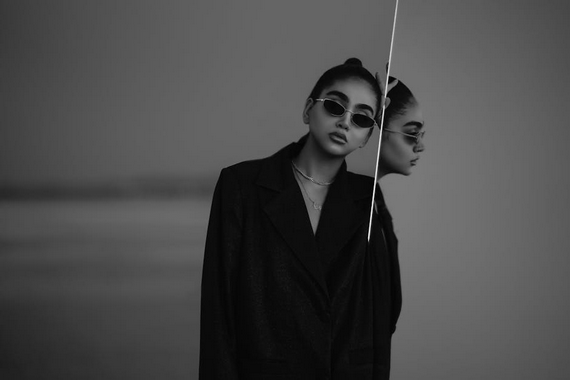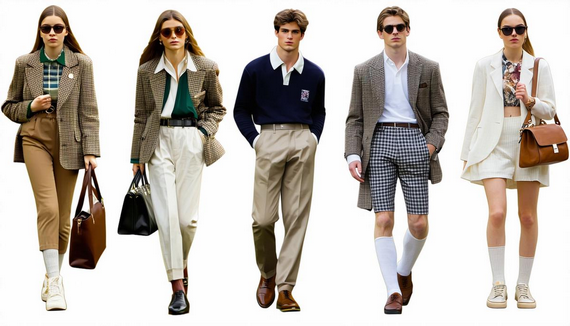Key Fashion Trends of the 1990s
The 1990s were a time of contrasts in the key fashion trends of the 1990s, where the bold and rebellious met the sleek and refined. From grunge’s unkempt charm to the minimalist elegance that emerged, each style had its own voice. As we look back, these diverse influences continue to shape our wardrobes today.
Key Fashion Trends of the 1990s – Grunge and Casual Wear
The key fashion trends of the 1990s saw a fashion revolution with the grunge movement, challenging mainstream style norms. Grunge wasn’t just a trend; it was a statement against polished fashion. Flannel shirts, baggy jeans, and layered clothing transformed wardrobes from polished to perfectly unkempt.
Grunge style started in Seattle and quickly spread to teenagers’ closets everywhere. Flannel shirts, often oversized and worn over band tees or turtlenecks, became more than just a fashion choice—they were a statement. Baggy jeans contrasted sharply with the fitted styles of the late 80s, providing comfort and a rebellious vibe.
Layering was key in the key fashion trends of the 1990s, allowing for self-expression by mixing different textures, patterns, and fabrics. A casual wear uniform emerged:
- Graphic tees
- Hooded sweatshirts
- Chunky boots
This mix-and-match approach has left a lasting mark, with elements of grunge resurfacing today in ripped denim, plaid, and layered looks.
Mainstream fashion, initially put off by grunge’s rough edges, quickly embraced the key fashion trends of the 1990s. What was once considered rebellious soon appeared on runways and in fashion magazines. Even as the grunge era faded, its influence remained, paving the way for a raw, authentic aesthetic that values personal expression over opulence.
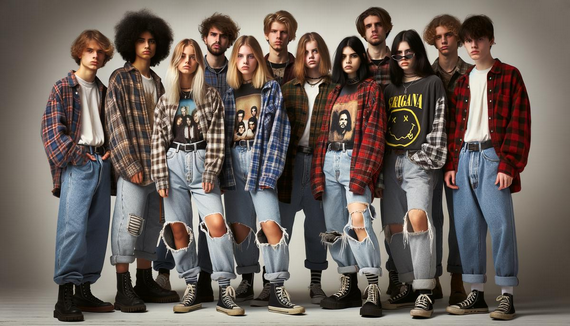
A group of young people wearing classic 90s grunge fashion, including flannel shirts, baggy jeans, and boots
Key Fashion Trends of the 1990s – Supermodels and Glamour
In contrast to grunge, the key fashion trends of the 1990s also saw the rise of supermodels. Icons like Cindy Crawford, Naomi Campbell, and Linda Evangelista didn’t just walk the runway; they defined it. These supermodels became household names, gracing magazine covers, billboards, and TV screens.
Cindy Crawford, with her signature beauty mark, became synonymous with 90s glamour. Naomi Campbell’s fierce presence set her apart, breaking barriers as one of the first black supermodels to achieve global acclaim. Together with Christy Turlington and Claudia Schiffer, they formed an elite group that transcended fashion, becoming influential tastemakers.
Their impact was profound, echoing in popular culture and everyday life. Supermodels achieved celebrity status akin to Hollywood stars, drawing unprecedented attention to fashion shows and making them cultural events. They influenced fashion trends, beauty standards, and attitudes about elegance and sophistication.
“Why are these girls so famous? Why are they personalities in their own right? Why are they known from one side of the globe to the other?”1
This glamorous side of 90s fashion highlighted the decade’s dynamic contrast to grunge. While grunge celebrated raw, unpolished expression, supermodels represented high-polished spectacle. Together, they showcased the diversity of personal style: one rebellious, the other aspirational.
The influence of 90s supermodels remains evident today in the fashion industry and our perceptions of beauty and style, underscoring that true glamour never goes out of fashion.
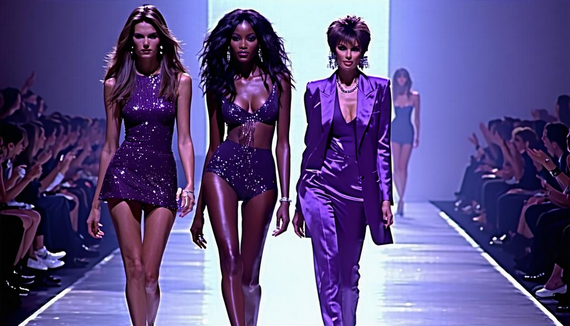
Iconic 90s supermodels Cindy Crawford, Naomi Campbell, and Linda Evangelista walking a fashion runway
Minimalism and High Fashion
While grunge and supermodels dominated the key fashion trends of the 1990s, another movement emerged: minimalism. Designers like Calvin Klein and Helmut Lang championed simplicity, embracing clean lines, muted palettes, and functionality. This aesthetic contrasted with both grunge and the glamour of supermodels, offering a thoughtful alternative.
Calvin Klein redefined elegance with understated sophistication. His designs removed frills, focusing on purity of form with sleek silhouettes and monochromatic tones. This cool, urban aesthetic was both accessible and aspirational, blending seamlessly into everyday life.
Helmut Lang approached minimalism with an avant-garde edge, merging functionality with fashion. His deconstructed tailoring and utilitarian pieces anticipated the blurring of fashion and function, speaking to a modern, metro-chic sensibility.
Minimalism’s influence extended beyond the runway, introducing an ideology that valued quality over quantity and subdued elegance over excess. It reflected a shift towards versatile, enduring garments, aligning with the economic prudence of the post-80s period.
Today, the minimalist movement’s legacy continues in contemporary interpretations. From capsule wardrobes promoting sustainable fashion to the appreciation of neutral tones, this style remains influential. Modern design houses still draw from this well of simplicity, demonstrating that the vision of Calvin Klein and Helmut Lang was more than a trend—it was a timeless philosophy of pared-back sophistication.
Reflecting on the key fashion trends of the 1990s in this vibrant decade, it’s clear that fashion is not just about clothes but a reflection of our evolving tastes and identities. The enduring appeal of 90s styles reminds us that true expression lies in embracing both simplicity and flair.
References:
- Woods V. Supermodels: The Sequel. Vogue. 1996;186(3):428-433.
1990s Grunge and Alternative Rock Fashion
1990s Grunge and alternative rock fashion, born from the streets of Seattle in the 1990s, offered a refreshing alternative to polished trends. Rooted in thrift shops and second-hand finds, it embraced comfort and individuality, challenging conventional fashion norms.
Key Fashion Trends of the 1990s – 1990s Grunge Fashion
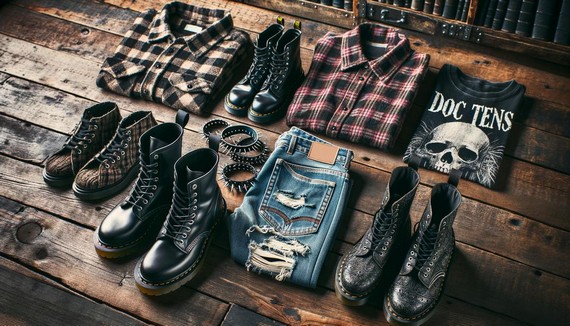
Grunge fashion essentials
Origins of 1990s Grunge and Alternative Rock Fashion
Grunge fashion emerged from the damp streets of Seattle in the 1990s, not from glossy magazines or high-end designers. This aesthetic was the offspring of the Pacific Northwest’s burgeoning music scene, with bands like Nirvana and Pearl Jam at the forefront.
Nirvana’s Kurt Cobain, with his oversized cardigans and scruffy jeans, became an unintentional style icon. This was fashion for those who shopped at second-hand stores, grabbing what they could find and making it their own. The mantra? Comfort and individuality rule.
Many saw mainstream fashion norms as a tedious cycle of must-haves. Grunge broke away, embracing a look that was raw, unrefined, and accessible. It was a thankful embrace of worn flannels and jeans that might have seen better days but still fit well.
In a time where heavily styled hair and shiny, neon garments were popular, grunge was a rebellion. Ripped jeans became a badge of honor, combat boots a declaration of independence, and flannel shirts tied it all together.
The essence of 1990s grunge and alternative rock fashion wasn’t about looking sloppy for the sake of it. It was about finding beauty and self-expression in the everyday and the ordinary. It was the sartorial equivalent of bucking against societal norms and being fiercely individual.
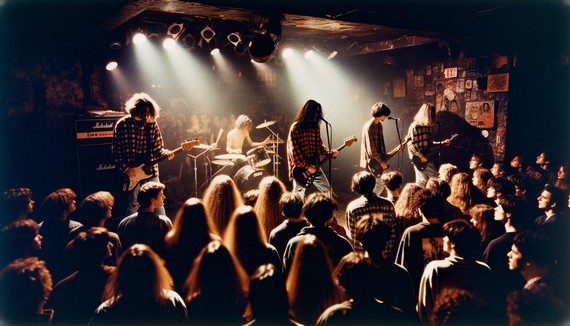
A grungy music venue in Seattle with a band performing on stage and audience in grunge attire
Key Elements of Grunge Style
Integral to 1990s grunge and alternative rock fashion were its defining elements:
- Slouchy silhouettes: Oversized flannel shirts and loose-fitting layers embodied a carefree spirit.
- Plaid prints: These became synonymous with grunge style, worn on shirts or tied around the waist.
- Distressed clothing: Tattered jeans and frayed hems weren’t just accepted; they were coveted.
- Layering: T-shirts under cardigans, topped with jackets – a mix that defied conventional styling.
- Accessories: Doc Martens boots and chokers added to the nonconformist look.
This compilation of elements fostered an aura that mirrored the music: raw, unapologetic, and unrefined. 1990s grunge and alternative rock fashion was never about fitting into a neat box; it was about being unique and authentic.
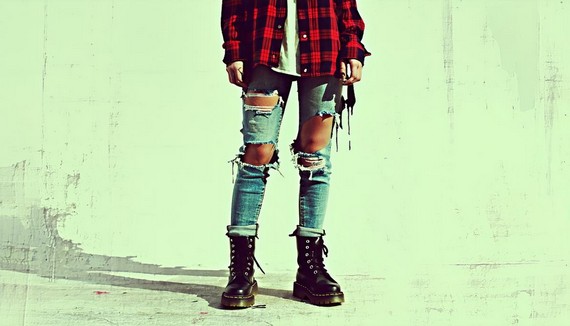
A person wearing typical grunge fashion including a plaid shirt, ripped jeans, and Doc Martens boots
Influential Icons of Grunge Fashion
Kurt Cobain and Courtney Love were the living emblems of grunge fashion.
Cobain, the frontman of Nirvana, embraced thrifted threads—oversized cardigans, band tees, and battered denim. His style conveyed an unspoken truth: comfort and genuineness trump pretense. Paired with Converse sneakers, his look became iconic.
Courtney Love brought a different twist to grunge. As the lead vocalist of Hole, she stood out with her blend of babydoll dresses and torn stockings. Her “kinderwhore” look juxtaposed lacy frocks with smudged makeup and unkempt hair, creating a unique blend of femininity and rebellion.
Together, Cobain and Love embodied dual facets of 1990s grunge and alternative rock fashion. Their wardrobes weren’t just about aesthetics; they represented an ethos that challenged fashion norms. They left a legacy that continues to inspire, reminding us that authenticity introduces more style than even the most perfectly curated outfit ever could.
Kurt Cobain and Courtney Love in their iconic grunge outfits
Grunge and Alternative Rock Fashion’s Legacy and Revival
The legacy of 1990s grunge and alternative rock fashion in the key fashion trends of the 1990s continues to resonate in modern style. Its periodic revival is a reclamation of authenticity, nodding to the irreverence that grunge celebrated.
The 2020s have seen a resurgence of grunge, ignited by Generation Z’s passion for thrifting and sustainable living. As this generation navigates through fast fashion, they’re drawn to styles that prioritize authenticity over trends – a philosophy rooted in grunge’s DNA.
Contemporary fashion has embraced grunge’s high-low mix. Thrifted treasures are paired with modern pieces, honoring grunge’s ethos while giving it room to evolve. High-fashion houses have also incorporated grunge elements into their collections, adding a refined touch to its unrestrained style.
Today’s grunge revival continues to embolden the fashion landscape with its quest for sincerity. It speaks to a generation seeking authenticity, urging them to find style cues in their own character rather than fleeting trends. This resurgence is more than homage; it’s a reclamation of grunge’s raw soul, bearing the timeless message that fashion is about self-expression, not conformity.
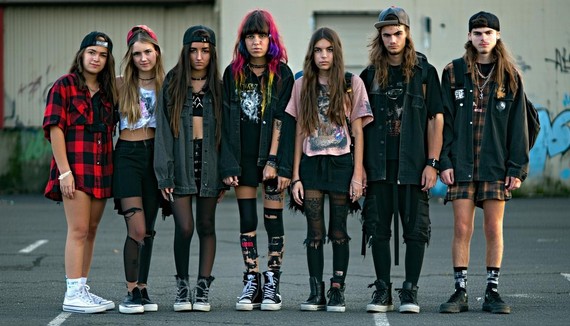
A group of young people wearing modern interpretations of grunge fashion
1990s grunge and alternative rock fashion’s enduring legacy celebrates authenticity over artifice. As it continues to inspire new generations, its message remains clear: true style is found in self-expression and sincerity, not in conforming to fleeting trends.
References:
- Frank A. Kurt Cobain: The antithesis of the macho American man. Vogue. 2014.
- Morris B. Grunge: A success story. The New York Times. 1992.
- Sinclair R. Gen Z and the resurgence of grunge fashion. Fashion Snoops. 2023.
1990s Minimalist and Athleisure Trends
There was a shift towards 1990s minimalist and athleisure trends in fashion. Designers like Calvin Klein and Helmut Lang moved away from the bold colors of the 80s, favoring neutral palettes and simple aesthetics. This approach quickly influenced the fashion scene.
1990s Minimalist and Athleisure Trends Fashion Revival
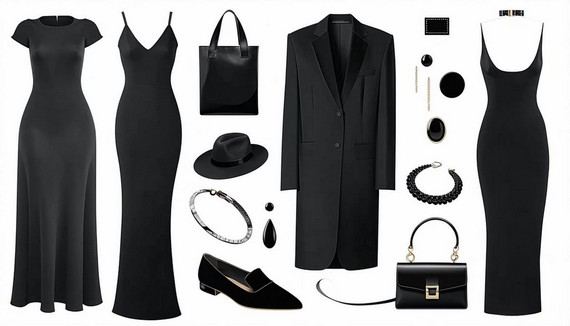
1990s minimalist fashion essentials
90s Minimalism in Fashion
Calvin Klein crafted sleek, uncomplicated silhouettes that exuded timeless allure. His philosophy of “less is more” still resonates in the fashion world today.
Helmut Lang brought an industrial edge to 1990s minimalist trends, focusing on high-quality fabrics and straightforward designs. His attention to texture and quality over ornate details left a lasting impact on modern fashion.
Today, these 1990s minimalist and athleisure trends continue to thrive. Brands like COS and Uniqlo have perfected this aesthetic, offering simplicity and elegance amidst colorful fast fashion. The athleisure trend, born from minimalist principles, also owes its popularity to this era.
If your wardrobe feels overloaded, consider stripping things down and letting simple, well-made pieces speak for themselves.
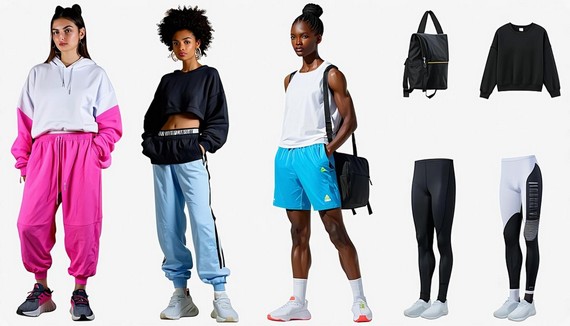
A curated collection of 90s minimalist fashion pieces including a sleek Calvin Klein dress, Helmut Lang blazer, and simple accessories
Key Fashion Trends of the 1990s – Rise of Athleisure in the 1990s
The key fashion trends of the 1990s saw the emergence of the athleisure trend, blending athletic wear with everyday fashion. This trend stemmed from the decade’s embrace of comfort, practicality, and a more relaxed lifestyle.
High fashion recognized that comfort and style could coexist in 1990s minimalist and athleisure trends, resulting in streamlined silhouettes and breathable fabrics that aligned with the decade’s minimalistic aspirations.
Hip-hop culture played a crucial role in popularizing this 1990s athleisure trend. Artists demonstrated that comfort and style weren’t mutually exclusive, elevating tracksuits, trainers, and fitted caps to wardrobe staples.
The skater scene contributed its own flair, advocating for practical, yet stylish clothing. Combined with the growing gym culture, a new trend and market emerged in the 1990s for attire that complemented active lifestyles.
Today, athleisure is a staple in fashion-conscious streets everywhere, valued for its blend of practicality, comfort, and style. It’s about feeling good as much as looking good, a legacy of those 1990s minimalist and athleisure trends that paved the way.
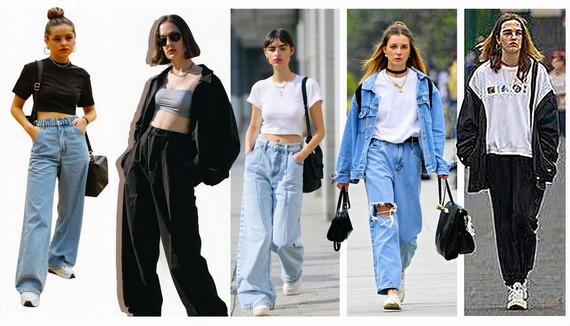
A timeline-style image showing the evolution of athleisure fashion from 90s sportswear to modern interpretations
Icons of 1990s Minimalist and Athleisure Trends
Carolyn Bessette-Kennedy epitomized elegance in the 1990s minimalist trend. Her style conveyed refinement without ostentation, seamlessly transitioning from casual chic to sophisticated glamour. Her timeless approach, prioritizing quality over quantity, continues to inspire modern fashionistas seeking beauty in simplicity.
Kate Moss became the poster girl for grunge-meets-elegance. Her waif-like silhouette and affinity for slip dresses and relaxed outfits challenged traditional key fashion trends of 1990s glamour. Moss brought fresh energy and raw authenticity that still resonate today, evident in the current trend of mixing elegant pieces with casual essentials.
Designers Calvin Klein and Helmut Lang were 1990s minimalist and athleisure trend pioneers, creating pieces that emphasized fabric quality as much as form. Their philosophy is embraced in today’s sustainable and capsule wardrobe movements.
1990s Minimalist and Athleisure Trends: Princess Diana contributed to the 1990s athleisure trend, mastering the art of combining sporty and stylish with her iconic cycling shorts and oversized jumpers. Her ability to wear athletic gear with grace continues to inspire those seeking to balance comfort and trend.
These icons and designers redefined the fusion of fashion and everyday life. Their influence on 1990s minimalist and athleisure trends continues to stride down today’s catwalks, reminding us that style’s power lies in both statement and subtlety.
A stylised portrait collection of 90s fashion icons including Carolyn Bessette-Kennedy, Kate Moss, and Princess Diana
As we reflect on the enduring influence of 1990s minimalist and athleisure trends it’s clear that simplicity and comfort have left a lasting mark. Whether through minimalist elegance or the relaxed vibe of athleisure, these styles continue to resonate today. Embracing these timeless elements can bring both style and ease into our wardrobes.
References:
- Woods V. Supermodels: The rise of models as muses and celebrities. Vogue. 1991;181(7):116-121.
- Menkes S. Grunge: The laid-back look trickles up to high fashion. Vogue. 1993;183(1):80-82.
- Meisel S. Minimalism reigns: Fashion strips down. Vogue. 1996;186(5):220-225.
- Vogue. Digital age: Fashion goes cyber. 1994;184(3):150-154.
1990s Preppy and School-Inspired Looks Fashion Evolution
In the 1990s preppy and school-inspired looks in fashion returned to prominence, influenced by the ‘Official Preppy Handbook’ and celebrity style choices. Plaid blazers paired with khakis became a signature look, transitioning easily from classrooms to casual gatherings. Khakis evolved beyond a wardrobe staple, balancing formality and ease.
Key Fashion Trends of the 1990s – Evolution of the Preppy Style
Nautical inspirations introduced stripy rugby shirts and sailing motifs, adding maritime elegance to global wardrobes. Familiar faces like Princess Diana appeared in tartan blazers and polo necks, embodying the preppy persona and influencing high street fashion.
The iconic film Clueless showcased this aesthetic, making preppy fashion accessible and aspirational without snobbery. Silks, soft knits, and slightly oversized sweaters were embraced by fashion enthusiasts, worn as easily on seaside strolls as in urban settings.
The understated charm of 1990s preppy and school-inspired looks, with its iconic items and timeless influences, continues to resonate in the modern era—a nod to a distinguished past and a testament to style’s ongoing progression.
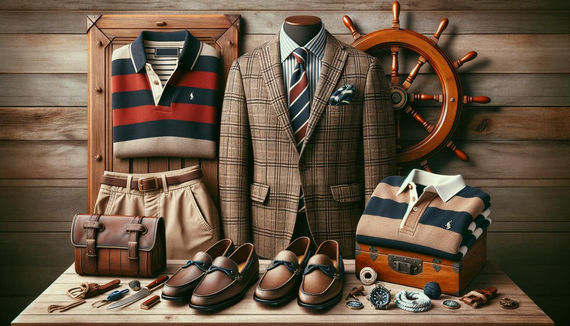
A stylish arrangement of 1990s preppy fashion essentials including a plaid blazer, khakis, a striped rugby shirt, and loafers
Modern Adaptations of 1990s preppy and school-inspired looks
Today, the 1990s preppy and school-inspired looks aesthetic blends with contemporary influences. The iconic plaid blazer reappears in modern cuts and fabrics, emphasizing inclusivity and versatility. Athleisure has entered the preppy sphere, creating an intriguing mix of tradition and modernity. A crisp preppy polo shirt might pair with relaxed joggers, suitable for a cozy brunch or an energetic workout.
The gender-neutral movement provides new opportunities for preppy reinvention. Oversized collegiate sweaters are embraced regardless of gender, creating space for anyone to incorporate collegiate charm into their personal style.
Modern celebrities draw inspiration from this revival. Harry Styles confidently wears checkered ensembles that reference classic preppy roots while presenting a fresh, gender-fluid aesthetic. Emma Chamberlain translates nostalgic tennis-inspired looks for social media, balancing tradition with youthful energy.
This is the essence of modern preppy fashion; it honors its origins while incorporating current trends. From sailor chic with a modern twist to academia-inspired looks adopted by Gen Z, the core of 90s preppy style remains vibrant, demonstrating its ability to adapt and inspire within contemporary fashion.
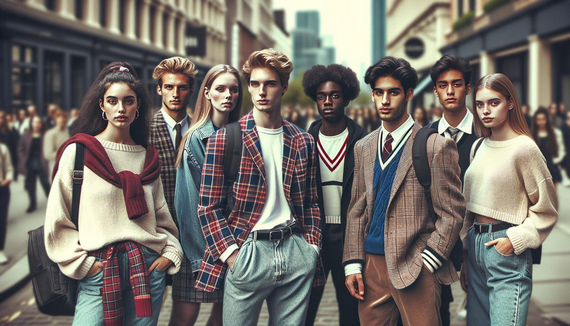
A diverse group of young people wearing modern interpretations of preppy fashion, including athleisure-inspired outfits and gender-neutral collegiate wear
1990s preppy and school-inspired looks, rooted in tradition, continues to inspire and adapt. Its ability to combine classic elegance with modern sensibilities ensures its ongoing relevance and appeal across generations.
References:
- The Official Preppy Handbook. Workman Publishing, 1980.
- Birnbach L. True Prep: It’s a Whole New Old World. Knopf, 2010.
- Heckett C. Preppy: Cultivating Ivy Style. Rizzoli, 2012.



